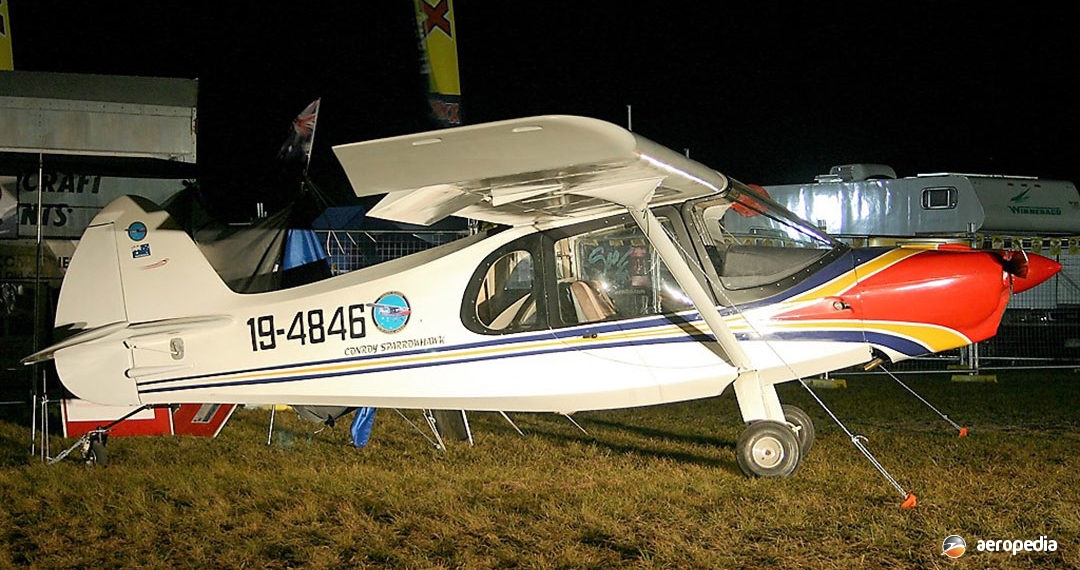Photograph:
Conroy Sparrowhawk 19-4846 (c/n 1) (Ray Vuillerman collection)
Country of origin:
Australia
Description:
Two-seat light sport aircraft
Power Plant:
One 60 kw (80 hp) Jabiru 2200 four-cylinder horizontally-opposed air-cooled engine
Specifications:
- Wingspan (standard wing): 9.5 m (31 ft 2 in)
- Length: 5.79 m (19 ft)
- Height: 2.48 m (8 ft 1 in)
- Wing area: 11.14 m² (120 sq ft)
- Max cruising speed at 3,300 rpm: 232 km/h (144 mph)
- Cruising speed at 3,000 rpm: 204 km/h (127 mph)
- Stalling speed clean: 52 km/h (32 mph)
- Stalling speed with flaps: 41 km/h (25 mph)
- Rate of climb at 111 km/h (69 mph): 305 m/min (1,000 ft/min)
- Empty weight: 285 kg (628 lb)
- Loaded weight (amateur built): 544 kg (1,199 lb)
- Design weight limit: 625 kg (1,378 lb)
History:
The Conroy Sparrow XC was an Australian-designed single or two-seat light aircraft supplied in kit form to be completed in the amateur built or experimental categories. Designed by Christopher Conroy, it was one of a series of designs made available by Conroy Aircraft Components of Oxenford, QLD.
Ideal for short, rough fields, it was described as a comfortable touring aircraft and could be fitted with engines in the 37 kw (50 hp) to 60 kw (80 hp) range. Built of fibreglass composite for strength, safety and ease of construction, it was available substantially complete, requiring only final assembly, systems, engine installation, and painting.
The prototype of the production model, the Sparrow SC 19-3458 (c/n 003), was first flown at Watts Bridge, QLD on 29 March 2001 at 1700 hrs and since then development has continued, being followed by Sparrow XC 19-3635 (c/n 002).
Mr Conroy has been involved in designing and building light aircraft since the 1980s, one of his first designs being the Conroy Cormorant which was an ultra-light aircraft fitted with floats.
The Sparrow series could be built with a standard wing or a STOL wing, amphibious or non amphibious floats, in which form it was known as the Conroy Colt floatplane, and could be fitted with an under-fuselage cargo pod. The fuselage could be built in two-seat in tandem configuration or in a two-seat side-by-side form. The wing area and fuel capacity could be adjusted during building to suit specific tasks. An extended wing could be built to allow for power soaring, or a short wing for cross-country flying. Flying and control surfaces were interchangeable, and the wings were detachable for trailering. A range of engines was available, including the 2.2 litre Jabiru, 3.3 litre Jabiru, Rotax 503, 582, 618, 912, 914, Hirth and Subaru.
A variant known as the Sparrowhawk was developed and made available to the home-built aircraft market.
First aircraft completed in the series was registered as 10-0065 (c/n 002) under AUF 95:10 rules. Further aircraft registered under Recreation Aircraft Association (RAA) Regulations have included 19-3201 (c/n CA-308); 19-3458 (c/n 003), 19-3635 (c/n 002); 19-7515 (c/n SG-001); and Sparrowhawk 19-4846 (c/n 1) fitted with a Jabiru 3300 engine.

